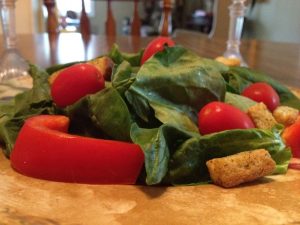Celebrating Sassy Salads! Happy National Salad Month
 Salads have gotten a bad reputation as being a notorious diet food. You think about a bowl full of iceberg lettuce and a couple of tomatoes thrown in and you would be right to picture salads as the enemy. But this month we celebrate salad, and look at the ways it can be satisfying as well as healthy.
Salads have gotten a bad reputation as being a notorious diet food. You think about a bowl full of iceberg lettuce and a couple of tomatoes thrown in and you would be right to picture salads as the enemy. But this month we celebrate salad, and look at the ways it can be satisfying as well as healthy.
Think of salads as a blank canvas. There are no limitations when it comes to flavor combinations and ingredients to include. First, you want to start out with your base. People tend to gravitate towards old classics like iceberg and romaine lettuce, but in terms of leafy greens, there are some better salad bases out there. For example, try kale, arugula, or Swiss chard or get creative and use shredded carrots or even chopped vegetables instead of a green salad base.
When it comes to toppings, focus on veggies first (tomatoes, celery, carrots, jicama, cucumber, radishes, beets), and then based on your veggies, pair fruits that will go with the veggies you chose. For example, carrots and grapes go very well together, and beets and apples are a nice pairing as well. Depending on your fruits and veggie choices, you can eat 2-3 of your fruit and vegetable servings for the day in one sitting!
If you are making your salad a meal, toss in some tasty lean proteins. Beans are great in salads because their size and shape combine nicely with cut up fruits and vegetables. Chicken, turkey, tofu, shrimp, “ahi tuna” and salmon are also delicious proteins to mix into salads. For those of you not familiar with “ahi tuna” it is a fish usually used in sushi and sashimi but many restaurants now have “ahi tuna” salads where the tuna is seared and they are almost always on the calorie conscious menu.
After you have your base and proteins picked out, now you can get really creative. You want to give your salad some different texture. Add some crunch by toasting up your own whole grain croutons, or tossing in almond slivers and walnuts. Choose low fat versions of feta and cheddar and toss an ounce into your salad to get one of your dairy servings in for the day. You can also theme your salad and top it based on that—if you want a southwest salad, top your salad with roasted corn kernels or wasabi peas for some spice and crunch. Toss in an ounce of avocado for some healthy monounsaturated fat. If you want a more Asian-themed salad, go with bean sprouts, sesame seeds and soba noodles to add some new flavors.
When going out to dinner, people who are trying to make healthy choices sometimes go right for the salads. Many times that seems like a great strategy however, restaurants sometimes ruin the healthy properties a salad can provide. One thing to watch out for is dressings. Some dressings (like Ranch or Caesar) are made up from unhealthy amounts of cream and oils, versus healthier vinaigrettes made from vinegars, herbs and spices. Your best bet is getting dressings on the side and controlling the amount you put on your plate. Or, be safe and use olive oil and vinegar. Also be aware of toppers like fried wontons, croutons, fried chicken, sour cream, or enormous amounts of cheese. As long as you are aware of what is in the salad, it can be healthy choice at a restaurant.
So let’s give salad some credit for being a delicious and filling way to be healthy at home, or when eating out.
What are some ways you have sassed up your salad lately?


That’s a good post.